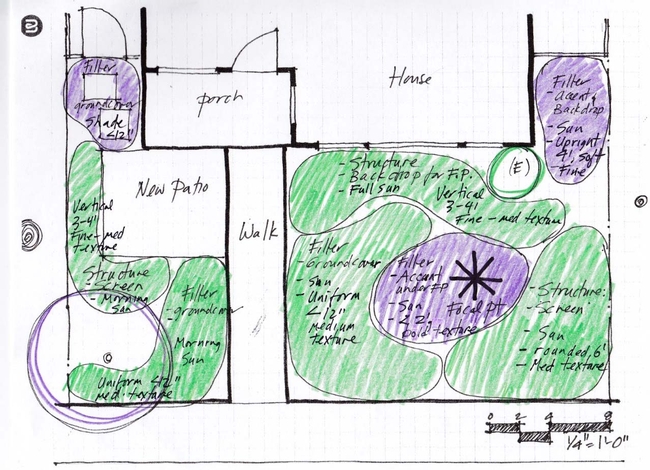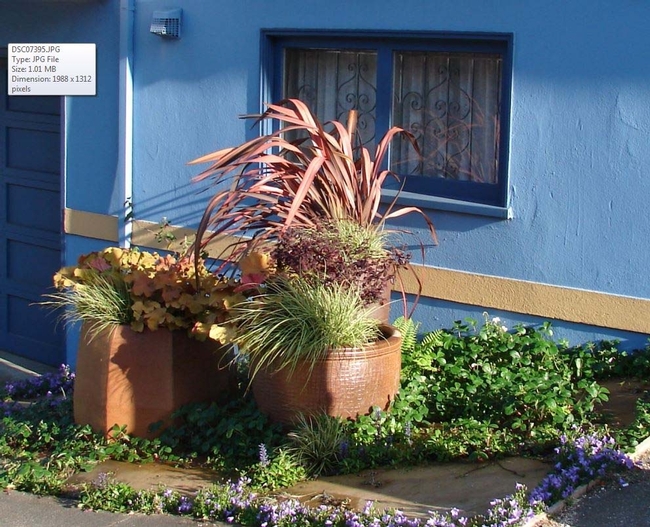Site map and analysis completed, per Part One? Check! Garden style selected, per Part Two? Check! Welcome to Part Three, where the focus is: What plant “jobs” need to be filled in my garden? Plants jobs can be functional, aesthetic, or both.

Aesthetic jobs affect the sensory aspects of a garden. These are primarily visual influences but also include scent, sound, and touch. Pleasing plant designs take texture, form, and color into consideration, incorporating these attributes through the principles of rhythm, line, balance, contrast, and unity.
- A plant's texture describes the size of its foliage and flowers and ranges from coarse to fine. Drifts of fine-textured plants tend to make the spaces in which they are planted seem larger. Bold-textured plants add flair to a garden.
- When referring to an entire plant, form describes its overall shape and stature. Plants with bold horizontal or vertical lines or strong visible branching are highly structural. They visually anchor a garden and add drama. Plants with rounded or billowy shapes contrast with and soften structural plants. Form also describes the varied shapes of individual flowers (for example: spires, balls, umbels, plumes or daisy-like configurations). Drifts of contrasting flower forms add interest to a garden.
- Infinite color palettes can be created with foliage and flower color. Foliage offers long term color, while flowers provide their hues in shorter bursts. Plant color palettes can be generally categorized as “cool” or “warm.” Cool palettes mingle purples, blues, grays, pinks with blue undertones, and pure- or greenish-yellows. Reds, bronzes, and oranges create a warm palette. Pinks with red undertones and orangey yellows go in a warm palette, too. Color palettes can also be monochromatic, combining different plants that have foliage, flowers or bark in the same color, such as red, yellow, blue/gray, or even white. Planting red, yellow, and blue together produces a garden in “primary” colors. And don't forget that green, in all its various shades, is a color.
- Repetition of any or all of the three attributes (texture, form, and color) creates rhythm in a garden. Gentle contrasts between texture and form and a monochromatic color palette make for subtle rhythm. For pizazz, bump up the contrast between form and texture or use vivid colors.
- Line is used to emphasize garden style and create directional cues. Plantings and hardscape can be used to create lines that lead the eye through a garden. For example, the line of a path or converging lines of plantings draw the eye to a focal point while curving paths, with destinations that are hidden by plants, invite the curious to explore a garden.
- In design, balance is the principle of distributing visual weight equally. Plant mass and color both affect balance. In a symmetrically balanced garden, opposing areas are mirror images of each other with similar plantings used on either side. In an asymmetrically balanced garden, unlike elements can balance each other. For example, a single strongly structural plant can be balanced by a boldly colored mass of filler plants.
- Contrast and unity are partners in well-designed gardens. Interesting gardens require contrast while unity ties it all together. To achieve unified contrast, follow the 2:1guideline: Select any two of the plant attributes (texture, form and color) to create either unity or contrast. The third attribute will oppose the other two. For instance, contrast texture and form while using color to unify the overall scheme. Such a garden could feature bold and finely textured plants along with highly structural plants and billowy filler plants, all tied together by a monochromatic color palette. Applying the principles of rhythm, line, and balance will further unify the design.

For this phase, think about plant functions rather than individual plants. Start by ‘bubbling in' the location of structural plant masses, and then add filler plant masses. Within each bubble, note the plant function (shade tree, screen plant, accent), the cultural conditions, and whether the plant(s) are to be evergreen or deciduous. Next, think about which plant attributes you want to use to provide contrast and which ones will provide unity. Assign texture and form attributes to each of the bubbles, keeping in mind the 2:1 guideline. Double check to see that you have arranged the plant attributes to provide rhythm, line, and balance in a way that reinforces your garden style.
Your completed preliminary planting plan will show separate bubbles labeled with plant form, function, cultural conditions, foliage type (evergreen or deciduous) and plant attributes.
A special bonus section of this series will focus on developing a plant list based on your preliminary planting plan. Then, stay tuned for our final and fourth guiding question: is my yard ready to plant? Happy Gardening!
This series of four Real Dirt articles summarizes the presentation Butte County Master Gardener Eve Werner created for the Butte County Master Gardeners Spring 2017 Workshop Series.
UC Master Gardeners of Butte County are part of the University of California Cooperative Extension (UCCE) system. To learn more about us and our upcoming events, and for help with gardening in our area, visit our website. If you have a gardening question or problem, email the Hotline at mgbutte@ucanr.edu (preferred) or call (530) 538-7201.


